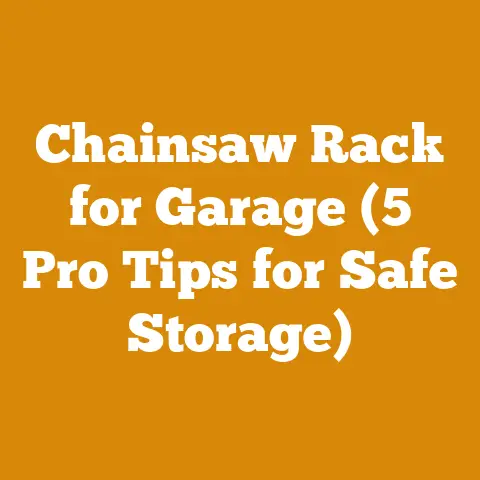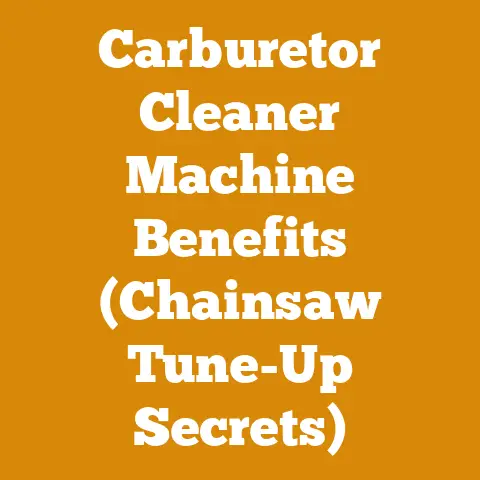Stihl Bars Compatibility (5 Key Chainsaw Parts)
Understanding the Importance of Bar Compatibility
Using the wrong bar on your Stihl chainsaw can lead to a host of problems. I have seen it all, from reduced cutting efficiency and premature wear to potentially dangerous kickback situations. The bar is the foundation upon which the cutting chain rides. If it’s not a proper match, the entire system suffers.
Think of it like this: you wouldn’t put the wrong tires on your truck and expect it to perform optimally. The same principle applies to your chainsaw. The bar, chain, and sprocket must work in harmony. This guide will help you avoid costly mistakes and keep your Stihl chainsaw running smoothly.
Key Chainsaw Parts Affecting Bar Compatibility
Let’s break down the five most important chainsaw parts that influence bar compatibility. Each of these elements plays a crucial role in ensuring that your chainsaw operates safely and efficiently.
- Mounting Pattern: This is the primary factor determining whether a bar will physically fit your chainsaw.
- Gauge: The gauge refers to the thickness of the drive links on your chain.
- Drive Links: The number of drive links on your chain must match the bar’s length and sprocket’s specifications.
- Chain Pitch: The pitch is the distance between the chain’s rivets.
- Sprocket Nose Type: The sprocket nose at the bar’s tip affects cutting speed and kickback potential.
1. Mounting Pattern: The Foundation of Compatibility
The mounting pattern is the shape and size of the slot on the chainsaw bar that attaches to the powerhead. It’s the most fundamental aspect of bar compatibility. If the mounting pattern doesn’t match your chainsaw model, the bar simply won’t fit.
Identifying Your Chainsaw’s Mounting Pattern
Stihl, like other chainsaw manufacturers, uses different mounting patterns for various models. The best way to identify your chainsaw’s mounting pattern is to consult your owner’s manual. The manual will typically specify the correct bar mount for your specific model.
Another method is to visually compare your existing bar’s mounting pattern to diagrams available online or in chainsaw parts catalogs. Several websites offer detailed schematics of Stihl bar mounts.
Common Stihl Mounting Patterns
Here are some common Stihl mounting patterns and the chainsaw models they typically fit:
- Stihl 3005 (Small Mount): Commonly found on smaller, homeowner-grade saws like the MS 170, MS 180, MS 193, MS 211, MS 230, and MS 250. This mount is characterized by its relatively small size and two elongated slots for the bar studs.
- Stihl 3003 (Large Mount): Used on larger, professional-grade saws such as the MS 261, MS 291, MS 311, MS 362, MS 391, MS 441, and MS 462. This mount is larger than the 3005 and often features a more robust design.
- Stihl 3002 (Older Large Mount): Found on some older Stihl models like the 026, 036, and 046. While similar to the 3003, there are subtle differences, so it’s not always interchangeable.
- Stihl 3006 (Specialized Mount): Used on specific models like the MS 201 and MS 201T. This mount is designed for compact saws requiring a narrow bar.
The Importance of Precision
Even slight variations in the mounting pattern can prevent a bar from fitting properly. Forcing a bar onto a chainsaw with an incompatible mount can damage both the bar and the saw. Always double-check the mounting pattern before purchasing a new bar.
My Experience with Mounting Patterns
I once tried to fit a bar from an MS 261 onto an MS 250, thinking they were close enough. The bar studs lined up, but the oiler hole didn’t align, and the bar wouldn’t seat properly.
Takeaway
Always verify the mounting pattern of your Stihl chainsaw before buying a new bar. Consult your owner’s manual or compare your existing bar to detailed schematics to ensure a perfect fit.
2. Gauge: Ensuring Smooth Chain Movement
The gauge refers to the thickness of the drive links on your chainsaw chain. It’s the portion of the chain that fits into the groove of the bar. Using the correct gauge is crucial for smooth chain movement and proper lubrication.
Understanding Gauge Measurements
Gauge is typically measured in thousandths of an inch (e.g., .043″, .050″, .058″, .063″). The most common gauges for Stihl chainsaws are .050″ and .063″.
- .050″ Gauge: This is a common gauge for smaller to mid-sized Stihl chainsaws used for general cutting and firewood preparation.
- .063″ Gauge: This gauge is typically found on larger, more powerful Stihl chainsaws designed for professional logging and heavy-duty cutting.
Why Gauge Matters
If the chain gauge is too small for the bar groove, the chain will rattle and may derail. If the gauge is too large, the chain won’t fit into the groove at all. Both scenarios can lead to damage to the chain, the bar, and even the chainsaw itself.
Checking Your Chain Gauge
The gauge is usually stamped on the drive link of the chain. Look for a small number like “50” or “63,” which indicates the gauge in thousandths of an inch. You can also use a caliper to measure the thickness of the drive link.
Bar Groove Width
The bar groove width must match the chain gauge. Most Stihl bars are marked with the appropriate chain gauge. If you’re unsure, consult the bar’s packaging or the manufacturer’s specifications.
My Experience with Gauge Mismatches
I once inherited a Stihl MS 361 with a mismatched chain and bar. The chain was .050″ gauge, while the bar was designed for .063″. The chain rattled excessively and vibrated, making it difficult to control the saw. Replacing the chain with the correct .063″ gauge immediately resolved the issue.
Takeaway
Always match the chain gauge to the bar groove width. Check the markings on the chain and bar to ensure compatibility. Using the wrong gauge can lead to poor performance and potential damage.
3. Drive Links: The Key to Chain Length
Drive links are the small, tooth-like projections on the chainsaw chain that fit into the bar’s groove and are propelled by the sprocket. The number of drive links determines the chain’s overall length and must correspond to the bar’s specified length and the sprocket’s design.
Counting Drive Links
To determine the number of drive links on your chain, simply count them. Start at any point on the chain and count each drive link until you return to the starting point.
Drive Links and Bar Length
The number of drive links required depends on the bar’s length and the chain pitch. Longer bars require more drive links. Stihl bars are typically marked with the recommended number of drive links for a specific chain pitch.
Chain Pitch: A Related Factor
Chain pitch refers to the distance between any three consecutive rivets on the chain, divided by two. Common chain pitches include 3/8″ (0.375″) and .325″. The chain pitch and the number of drive links are interconnected. A 16″ bar with a 3/8″ pitch chain will require a different number of drive links than a 16″ bar with a .325″ pitch chain.
Finding the Right Number of Drive Links
The easiest way to determine the correct number of drive links is to consult your owner’s manual or the bar’s packaging. These resources will typically specify the required number of drive links for a given bar length and chain pitch.
Online Chain Length Calculators
Several online chain length calculators can help you determine the correct number of drive links based on your bar length and chain pitch. These calculators are a useful tool for ensuring compatibility.
My Experience with Drive Link Errors
I once ordered a replacement chain online without paying close attention to the number of drive links. The chain arrived, and it was too short to fit the bar properly. I had to return the chain and order the correct one with the appropriate number of drive links. This experience taught me to always double-check the drive link count before making a purchase.
Takeaway
The number of drive links on your chain must match the bar’s specified length and the chain pitch. Consult your owner’s manual or the bar’s packaging to determine the correct number of drive links.
4. Chain Pitch: Determining Cutting Aggressiveness
The chain pitch is the distance between any three consecutive rivets on the chain, divided by two. It’s a crucial factor in determining the chain’s cutting aggressiveness and compatibility with the bar and sprocket.
Common Chain Pitches
The most common chain pitches for Stihl chainsaws are:
- 3/8″ (0.375″): This is a popular pitch for mid-sized to larger chainsaws used for felling trees and processing timber. It offers a good balance of cutting speed and durability.
- .325″: This pitch is commonly found on smaller to mid-sized chainsaws used for general cutting and firewood preparation. It provides a smoother cut and is often preferred by homeowners.
- 1/4″ (0.250″): This smaller pitch is typically used on lightweight chainsaws and pole pruners. It’s designed for precise cutting and reduced kickback.
Why Chain Pitch Matters
The chain pitch must match the sprocket’s pitch and the bar’s sprocket nose (if applicable). Using a mismatched pitch can damage the chain, the bar, and the sprocket.
Identifying Chain Pitch
The chain pitch is often stamped on the drive link of the chain. Look for a number like “3/8” or “.325”. You can also measure the distance between three consecutive rivets and divide by two to determine the pitch.
Sprocket Compatibility
The sprocket on your chainsaw must match the chain pitch. If you’re changing the chain pitch, you may also need to replace the sprocket.
Bar Sprocket Nose Compatibility
If your bar has a sprocket nose, the sprocket nose’s pitch must also match the chain pitch. Using a mismatched sprocket nose can cause the chain to bind or derail.
My Experience with Chain Pitch Problems
I once tried to use a 3/8″ pitch chain on a chainsaw with a .325″ pitch sprocket. The chain wouldn’t engage with the sprocket properly, and the saw wouldn’t cut. I quickly realized my mistake and replaced the sprocket with a 3/8″ pitch model.
Takeaway
The chain pitch must match the sprocket’s pitch and the bar’s sprocket nose (if applicable). Check the markings on the chain, sprocket, and bar to ensure compatibility.
5. Sprocket Nose Type: Minimizing Kickback
The sprocket nose is the small, rotating sprocket located at the tip of the chainsaw bar. It helps to reduce friction and improve cutting speed. However, it can also affect kickback potential.
Types of Sprocket Noses
There are two main types of sprocket noses:
- Hard Nose: This type of bar has a solid, non-rotating tip. It’s durable and requires less maintenance but can generate more friction and heat.
- Sprocket Nose: This type of bar has a rotating sprocket at the tip, which reduces friction and improves cutting speed. It also helps to reduce kickback.
Kickback and Sprocket Noses
Kickback occurs when the upper quadrant of the bar nose contacts a solid object, causing the chainsaw to suddenly thrust back towards the operator. Sprocket nose bars generally reduce kickback compared to hard nose bars because the rotating sprocket allows the chain to glide over the object more easily.
Sprocket Nose Maintenance
Sprocket nose bars require regular maintenance to ensure the sprocket rotates freely. This includes lubricating the sprocket with grease and checking for wear. A worn or damaged sprocket can increase kickback potential.
Replacing Sprocket Noses
Sprocket noses are replaceable. If the sprocket becomes worn or damaged, you can replace it with a new one. Be sure to use a sprocket nose that is compatible with your bar and chain pitch.
My Experience with Sprocket Nose Wear
I once noticed that the sprocket nose on my Stihl bar was not rotating smoothly. Upon closer inspection, I found that the sprocket was worn and had developed sharp edges. I replaced the sprocket nose with a new one, which significantly improved the saw’s performance and reduced the risk of kickback.
Takeaway
Sprocket nose bars can reduce kickback compared to hard nose bars. Regularly maintain your sprocket nose to ensure it rotates freely and replace it if it becomes worn or damaged.
Choosing the Right Stihl Bar: A Step-by-Step Guide
Now that we’ve covered the five key chainsaw parts that affect bar compatibility, let’s walk through the process of choosing the right Stihl bar for your chainsaw.
- Identify Your Chainsaw Model: The first step is to identify your Stihl chainsaw model. This information is typically found on a sticker or plate on the chainsaw’s housing.
- Consult Your Owner’s Manual: Your owner’s manual is the best resource for determining the correct bar length, mounting pattern, gauge, and chain pitch for your chainsaw.
- Measure Your Existing Bar (If Applicable): If you’re replacing an existing bar, measure its length, gauge, and mounting pattern. This will help you ensure that you choose a compatible replacement.
- Determine Your Cutting Needs: Consider the type of cutting you’ll be doing. For general cutting and firewood preparation, a shorter bar may be sufficient. For felling large trees, you’ll need a longer bar.
- Choose a Bar with the Correct Mounting Pattern: This is the most critical factor. Make sure the bar’s mounting pattern matches your chainsaw model.
- Select the Correct Gauge: Match the chain gauge to the bar groove width.
- Determine the Appropriate Number of Drive Links: Consult your owner’s manual or the bar’s packaging to determine the correct number of drive links for your bar length and chain pitch.
- Choose the Correct Chain Pitch: Match the chain pitch to the sprocket’s pitch and the bar’s sprocket nose (if applicable).
- Consider the Sprocket Nose Type: Decide whether you prefer a hard nose or sprocket nose bar. Sprocket nose bars generally reduce kickback.
- Purchase from a Reputable Dealer: Buy your Stihl bar from a reputable dealer who can provide expert advice and support.
Common Mistakes to Avoid
Choosing the wrong bar for your Stihl chainsaw can lead to frustration, poor performance, and even damage. Here are some common mistakes to avoid:
- Assuming All Stihl Bars Are Interchangeable: Stihl uses different mounting patterns for various models. Don’t assume that a bar from one Stihl chainsaw will fit another.
- Ignoring the Gauge: Using the wrong gauge can lead to poor chain movement and potential damage.
- Neglecting the Drive Links: The number of drive links must match the bar’s length and chain pitch.
- Mismatched Chain Pitch: The chain pitch must match the sprocket’s pitch and the bar’s sprocket nose (if applicable).
- Overlooking Sprocket Nose Maintenance: Neglecting to maintain your sprocket nose can increase kickback potential.
- Forcing a Bar to Fit: If a bar doesn’t fit easily, don’t force it. Double-check the mounting pattern and other specifications.
- Buying Cheap, Aftermarket Bars: While aftermarket bars may be cheaper, they may not meet Stihl’s quality standards. Stick with genuine Stihl bars for optimal performance and durability.
Maintaining Your Stihl Bar for Longevity
Proper maintenance is essential for extending the life of your Stihl bar. Here are some tips for keeping your bar in good condition:
- Clean the Bar Regularly: Remove sawdust, dirt, and debris from the bar after each use.
- Check the Bar Rails: Inspect the bar rails for wear and damage. File down any burrs or sharp edges.
- Lubricate the Sprocket Nose: If your bar has a sprocket nose, lubricate it regularly with grease.
- Flip the Bar: Periodically flip the bar over to distribute wear evenly.
- Check the Oiler Hole: Make sure the oiler hole is clear and unobstructed.
- Store the Bar Properly: Store the bar in a dry place to prevent rust.
Case Studies: Real-World Examples of Bar Compatibility
Let’s look at a few real-world examples of how bar compatibility can impact chainsaw performance.
Case Study 1: The Homeowner’s Dilemma
A homeowner purchased a used Stihl MS 170 for cutting firewood. The saw came with a 16″ bar, which seemed excessively long for the small engine. The homeowner struggled to make clean cuts and experienced frequent stalling. After consulting with a chainsaw expert, the homeowner learned that the MS 170 is best suited for a 14″ bar. Switching to a shorter bar significantly improved the saw’s performance and made it easier to handle.
Case Study 2: The Logger’s Challenge
A professional logger was using a Stihl MS 462 for felling large trees. The logger was experiencing frequent chain derailments and excessive bar wear. Upon closer inspection, it was discovered that the chain gauge was mismatched to the bar groove width. The logger replaced the chain with the correct gauge, which resolved the derailment issue and reduced bar wear.
Case Study 3: The Arborist’s Solution
An arborist was using a Stihl MS 201T for tree pruning. The arborist was concerned about kickback potential, especially when working in tight spaces. The arborist switched to a bar with a sprocket nose, which significantly reduced the risk of kickback and improved safety.
The Future of Chainsaw Bar Technology
Chainsaw technology is constantly evolving. In recent years, there have been several advancements in bar design and materials.
- Lightweight Bars: Manufacturers are developing lighter bars using advanced materials like carbon fiber and aluminum alloys. These bars reduce fatigue and improve maneuverability.
- Low-Kickback Bars: New bar designs are incorporating features that further reduce kickback potential.
- Improved Lubrication Systems: Advanced lubrication systems are ensuring that the chain and bar receive adequate oil, reducing friction and wear.
- Self-Sharpening Bars: Some manufacturers are experimenting with self-sharpening bars that automatically sharpen the chain while the saw is running.
Final Thoughts
Choosing the right Stihl bar for your chainsaw is crucial for safety, performance, and longevity. By understanding the five key chainsaw parts that affect bar compatibility – mounting pattern, gauge, drive links, chain pitch, and sprocket nose type – you can confidently select the perfect bar for your needs. Remember to consult your owner’s manual, measure your existing bar (if applicable), and purchase from a reputable dealer. With proper care and maintenance, your Stihl bar will provide years of reliable service.





